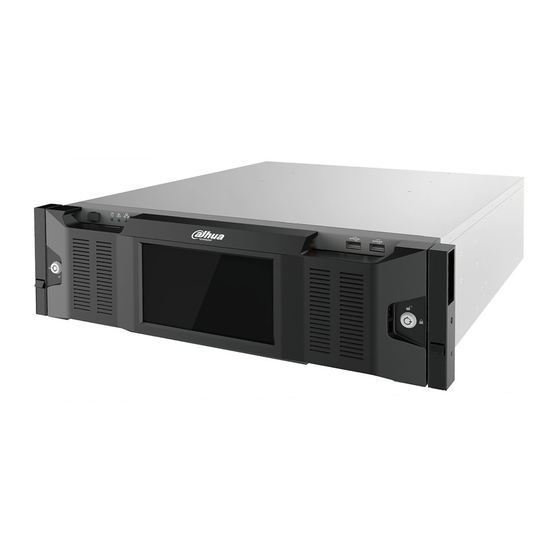Table of Contents
Advertisement
Advertisement
Table of Contents

Summary of Contents for Dahua DSS7016D-S2
- Page 1 DSS7016D-S2 Quick Start Guide V1.0.0...
-
Page 2: Foreword
Foreword General This manual introduces the quick start operations of the DSS general surveillance management platform. Models DSS7016D-S2, DSS7016DR-S2 Safety Instructions The following categorized signal words with defined meaning might appear in the manual. Signal Words Meaning Indicates a potential risk which, if not avoided, may result in property damage, data loss, lower performance, or unpredictable result. -
Page 3: Important Safeguards And Warnings
Important Safeguards and Warnings Operation Requirement ● Do not place or install the Device in a place exposed to sunlight or near the heat source. ● Keep the Device away from dampness, dust or soot. ● Keep the Device installed horizontally on the stable place to prevent it from falling. ●... -
Page 4: Table Of Contents
Table of Contents Foreword ..............................I Important Safeguards and Warnings ..................... II 1 Ports ............................... 1 1.1 Out-of-box Checking........................1 1.2 Panels and Ports ........................... 1 1.2.1 Front Panel ..........................2 1.2.2 Rear Panel ..........................3 1.3 Connecting Cables ........................4 2 Local Applications .......................... -
Page 5: Ports
1 Ports 1.1 Out-of-box Checking Check the package against the following checklist. If you find any damage or loss, contact after-sales service. Table 1-1 Checklist Checklist Quantity Description – Server – Hard Drive Bracket Hard Disk Screw 1 bag 68 screws, 4 for redundancy Power Cable 1.5 m 2 m (Gigabit CAT 5 twisted... -
Page 6: Front Panel
1.2.1 Front Panel Figure 1-1 Front panel Table 1-2 Front panel description Port or Button Description Press the button to start the server. Long press it Power button to shut down. Hard drive indicator The light flashes during disk-reading. light The blue light flashes when the server triggers an Alarm indicator light alarm. -
Page 7: Rear Panel
1.2.2 Rear Panel Figure 1-2 Rear panel (without redundancy power) Figure 1-3 Rear panel (with redundancy power) Table 1-3 Rear panel description Port or Tag Description Single power 100V AC–240V/47 AC–63Hz; supports hot swap. Reserved, used to connect to external RS485 Alarm output or input device. -
Page 8: Connecting Cables
1.3 Connecting Cables Connect cables according to port introduction, and then connect the server to power. -
Page 9: Local Applications
2 Local Applications 2.1 Function Architecture The section introduces the local applications of the device. See Figure 2-1 The local interface is displayed after the server is started. See Figure 2-2. Figure 2-1 Local functions Figure 2-2 Local interface... -
Page 10: System Configuration
2.2 System Configuration 2.2.1 Basic Settings Configure basic settings for the server. Click Basic Setting on the local interface. The Basic Setting interface is displayed. See Figure 2-3. For details, see Table 2-1. Figure 2-3 Basic settings Table 2-1 Parameter description Parameter Description System Time... - Page 11 Figure 2-4 Network Setting Table 2-2 Description Parameter Description The following 4 modes are available. ● Multi-address Multiple network card (hereinafter referred to as NIC) mode. You can configure different network parameters for different NICs to achieve high network reliability. For example, to configure hot spare, the NIC 2 can be used to set spare server IP.
-
Page 12: Operation Management
Parameter Description Select the default NIC which will forward the data packet from Default Port non-adjacent segment (such as WAN). IP Address Subnet Mask Select an NIC, and then set its IP address, subnet mask, default Preferred DNS gateway, preferred DNS server address and alternate DNS server address. - Page 13 Figure 2-6 Operation Analysis (2) Figure 2-7 Operation Analysis (3)
-
Page 14: System Management
Figure 2-8 Operation Analysis (4) Table 2-3 Description Detections Description Real-time detection of the status of platform server, such as Server Detection normal, stop and abnormal. Real-time detection of both upper and lower flow of physical Network Detection network port. Real-time detection of disk capacity, temperature, I/O load and HDD Detection health. - Page 15 Figure 2-9 System management Table 2-4 Description Operation Description Reboot Save system data before reboot. Shut down Save system data before shutting down. Password Reset current password. Enable SSH (22) port to avoid whitelist configuration error of the Config Reset Firewall System or access failure to the platform.
-
Page 16: Config System
3 Config System The local system only provides basic configurations, such as time, language, network and quick management. Log in to the Config System for further configurations of service, cluster, storage, linkage, map, database and security. For details, see User’s Manual. Enter http://IP/config in the address bar of browser to go to the Config System. -
Page 17: Appendix 1 Cybersecurity Recommendations
Appendix 1 Cybersecurity Recommendations Cybersecurity is more than just a buzzword: it’s something that pertains to every device that is connected to the internet. IP video surveillance is not immune to cyber risks, but taking basic steps toward protecting and strengthening networks and networked appliances will make them less susceptible to attacks. - Page 18 We suggest you to change default HTTP and other service ports into any set of numbers between 1024~65535, reducing the risk of outsiders being able to guess which ports you are using. Enable HTTPS We suggest you to enable HTTPS, so that you visit Web service through a secure communication channel.
- Page 19 suggested to use VLAN, network GAP and other technologies to partition the network, so as to achieve the network isolation effect. Establish the 802.1x access authentication system to reduce the risk of unauthorized access to private networks.








Need help?
Do you have a question about the DSS7016D-S2 and is the answer not in the manual?
Questions and answers